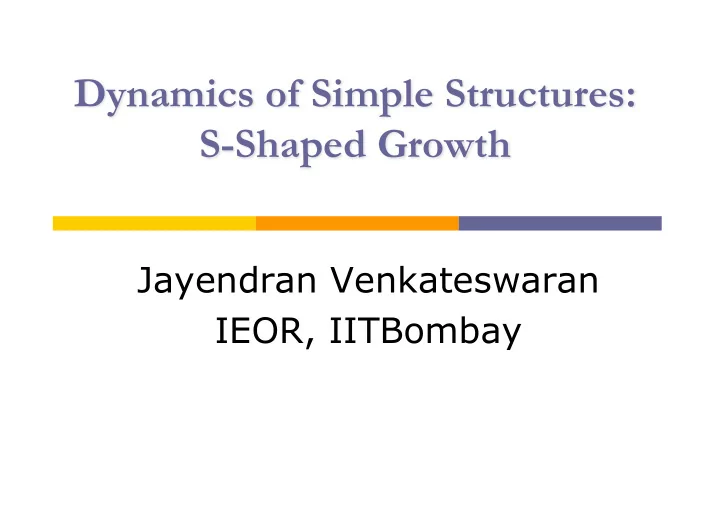

Dynamics of Simple Structures: S-Shaped Growth Jayendran Venkateswaran IEOR, IITBombay
Growth limited by capacity p Consider scenario + + Net Birth Rate Population + + - + Effective Fractional Birth Rate - Population/ Carrying Capacity + - Fractional Birth Rate Carrying Capacity p What will be expected behavior of system? p Plot the expected rate-level graph p How can we expect Fractional birth rate to change with the Population/Capacity ratio? IEOR, IIT Bombay IE 604: System Dynamics Modelling & Analysis Jayendran Venkateswaran
CLD to SFD model + Population (P) + Net Birth Rate Population Net Birth Rate + + + + - + Effective Fractional Effective frac birth rate Birth Rate + - - Population/ Carrying Capacity + + Population Capacity Ratio - - fractional birth rate (b) Fractional Birth Rate Carrying Capacity Carrying Capacity (C) p Assume carrying capacity is fixed (C=1000) p P 0 =2; b = 0.2 p Net Rate = b.(1-P/C).P IEOR, IIT Bombay IE 604: System Dynamics Modelling & Analysis Jayendran Venkateswaran
Let’s Simulate p Simulate the SFD model n What behavior pattern do you observe? n What is the stable population size? n When does population reach stability? n When is the ‘ inflection point ’ ? p Tips: Make Custom Graphs in Vensim p Click Control Panel à Graph n Rate-Level graph (Double click to view) n Eff_Brate graph (Double click to view) p What happens when P0 = 2000? IEOR, IIT Bombay IE 604: System Dynamics Modelling & Analysis Jayendran Venkateswaran
Improve model + + + - Net Birth Rate Population Death Rate - + + + - fractional death rate + Effective Fractional Birth Rate - Population/ Carrying Capacity + - Fractional Birth Rate Carrying Capacity p Let’s include Death Rate p What will be expected behavior of system? p Plot the expected Rate-Level graph p How can we expect Fractional Rates to change with the Population/Capacity ratio? IEOR, IIT Bombay IE 604: System Dynamics Modelling & Analysis Jayendran Venkateswaran
Let’s Simulate Deaths p Incorporate Deaths in your SFD model n Fractional death rate, d = 0.07 n Death Rate = d.P p Simulate the SFD model n What behavior pattern do you observe? n What is the stable population size? n When does population reach stability? n When is the ‘ inflection point ’ ? p Model NetRate = Births - Deaths p In Vensim, use Control Panel à Graph to create Rate-Level graph IEOR, IIT Bombay IE 604: System Dynamics Modelling & Analysis Jayendran Venkateswaran
More limiting factors p Suppose other limiting factors, such as starvation, affects death rate non-linearly. p What will be expected behavior of system? p Plot the expected Rate-Level graph p How can we expect Fractional Rates to change with the Population/Capacity ratio? IEOR, IIT Bombay IE 604: System Dynamics Modelling & Analysis Jayendran Venkateswaran
Let’s update model and Simulate p Update your SFD model n Create new variable effective-fractional-death-rate n Fractional death rate, d = 0.07 n Death Rate = d.(P/C).P p Simulate the SFD model n What behavior pattern do you observe? n What is the stable population size? n When does population reach stability? n When is the ‘ inflection point ’ ? IEOR, IIT Bombay IE 604: System Dynamics Modelling & Analysis Jayendran Venkateswaran
S-Shaped Growth p The behavior we disucssed is known as S- Shaped growth p S-shaped pattern exhibited by n Population trends of many animals & plants n Learning curves n Diffusion of news, riots, epidemics, & rumors n Growth of new products, & other socio- economic activities IEOR, IIT Bombay IE 604: System Dynamics Modelling & Analysis Jayendran Venkateswaran
Examples of S-shaped growth (1) Source: Sterman, John D. Business Dynamics (Fig 4-9) IEOR, IIT Bombay IE 604: System Dynamics Modelling & Analysis Jayendran Venkateswaran
Examples of S-shaped growth (2) http://www.life.umd. edu/classroom/biol1 06h/L28/L28_popeco .html Source: http://www.micro.ute xas.edu/courses/levin Tasmanian Sheep /bio304/com&pop/co mmunities.html IEOR, IIT Bombay IE 604: System Dynamics Modelling & Analysis Jayendran Venkateswaran
S-shaped growth summary p S-shaped or logistic or sigmoid growth n The time path includes two distinct regions n General behavior p Two types of generic structures can result in S-Shaped Behavior n First structure used to model growth with limiting factor n Second structure derived from systems involving epidemics, new product diffusion, and rumors. IEOR, IIT Bombay IE 604: System Dynamics Modelling & Analysis Jayendran Venkateswaran
Recommend
More recommend